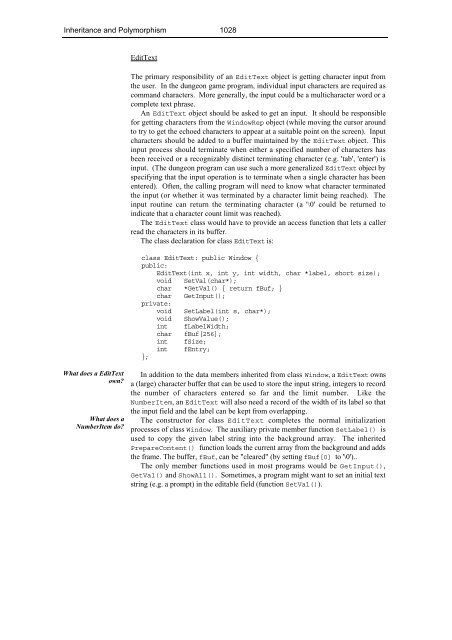29 The Power of Inheritance and Polymorphism
29 The Power of Inheritance and Polymorphism
29 The Power of Inheritance and Polymorphism
Create successful ePaper yourself
Turn your PDF publications into a flip-book with our unique Google optimized e-Paper software.
<strong>Inheritance</strong> <strong>and</strong> <strong>Polymorphism</strong> 1028EditText<strong>The</strong> primary responsibility <strong>of</strong> an EditText object is getting character input fromthe user. In the dungeon game program, individual input characters are required ascomm<strong>and</strong> characters. More generally, the input could be a multicharacter word or acomplete text phrase.An EditText object should be asked to get an input. It should be responsiblefor getting characters from the WindowRep object (while moving the cursor aroundto try to get the echoed characters to appear at a suitable point on the screen). Inputcharacters should be added to a buffer maintained by the EditText object. Thisinput process should terminate when either a specified number <strong>of</strong> characters hasbeen received or a recognizably distinct terminating character (e.g. 'tab', 'enter') isinput. (<strong>The</strong> dungeon program can use such a more generalized EditText object byspecifying that the input operation is to terminate when a single character has beenentered). Often, the calling program will need to know what character terminatedthe input (or whether it was terminated by a character limit being reached). <strong>The</strong>input routine can return the terminating character (a '\0' could be returned toindicate that a character count limit was reached).<strong>The</strong> EditText class would have to provide an access function that lets a callerread the characters in its buffer.<strong>The</strong> class declaration for class EditText is:class EditText: public Window {public:EditText(int x, int y, int width, char *label, short size);void SetVal(char*);char *GetVal() { return fBuf; }char GetInput();private:void SetLabel(int s, char*);void ShowValue();int fLabelWidth;char fBuf[256];int fSize;int fEntry;};What does a EditTextown?What does aNumberItem do?In addition to the data members inherited from class Window, a EditText ownsa (large) character buffer that can be used to store the input string, integers to recordthe number <strong>of</strong> characters entered so far <strong>and</strong> the limit number. Like theNumberItem, an EditText will also need a record <strong>of</strong> the width <strong>of</strong> its label so thatthe input field <strong>and</strong> the label can be kept from overlapping.<strong>The</strong> constructor for class EditText completes the normal initializationprocesses <strong>of</strong> class Window. <strong>The</strong> auxiliary private member function SetLabel() isused to copy the given label string into the background array. <strong>The</strong> inheritedPrepareContent() function loads the current array from the background <strong>and</strong> addsthe frame. <strong>The</strong> buffer, fBuf, can be "cleared" (by setting fBuf[0] to '\0')..<strong>The</strong> only member functions used in most programs would be GetInput(),GetVal() <strong>and</strong> ShowAll(). Sometimes, a program might want to set an initial textstring (e.g. a prompt) in the editable field (function SetVal()).
















